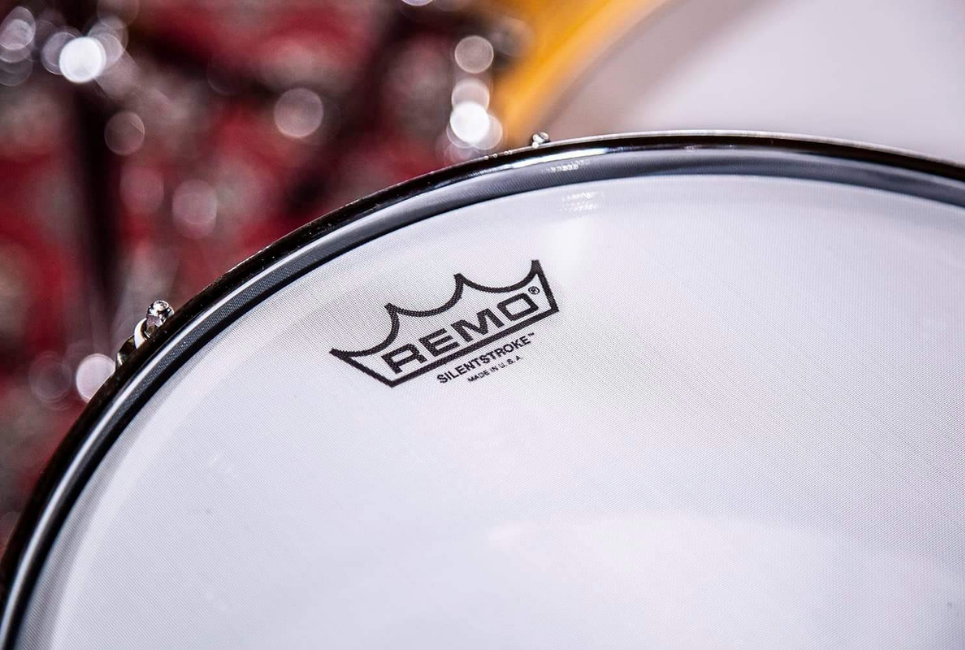- Vic Firth vs Promark Drumsticks - May 31, 2022
- Remo Silentstroke Review - May 21, 2022
- Alesis Strike Pro Review and Guide: All You Need to Know! - September 20, 2021
As every drummer will know, it takes a lot of commitment to dedicate yourself to such an instrument. Drums is not the most user-friendly instrument and the main reason for this is the sound volume that they produce naturally. Acoustic drum sets can produce volumes of up to 130 decibels, which should feel a bit like being around 50 feet away from a plane taking off.
For this reason, finding a space to practice (in peace!) is the bane of many drummers’ lives. Thankfully there are some helpful options out there which can help us happily play our instrument whatever the time of day.
In this review we will focus on the Remo Silentstroke drum head which has been specifically designed to reduce drum volume while maintaining a real-feel drumming experience.
Silentstroke Design
Remo are well-known for their innovation when it comes to musical instruments, and most drummers will recognise the brand from their hugely successful V-Drum series of electronic drums.
V-Drums are to the acoustic kit as a synthesizer is to a piano. Electronic drums have practically revolutionised the drumming world as they offer drummers a limitless palette of sounds and a near-silent practice tool.
The Remo Silentstroke drum head is similar to the mesh heads that you will find on most Roland V-Drums. It’s a sinlge-ply Kevlar head which is woven onto the drum hoop. The end result is a light drum head which has a cloth-like feel as opposed to a normal Mylar head which is smooth and flat.
I remember being amazed the first time I played on a Roland mesh drum kit as the feel was so much better than the old-style rubber pads. The playing experience is similar here.
Silentstroke heads offer up to a 70% reduction in volume when compared with acoustic Mylar heads. So, what does that sound like? Well, this video gives a quick insight into the difference. You’ll notice that it contains some low-volume cymbals, which we’ll touch on later.
Setting Up
Remo Silentstroke drum heads have been designed to fit practically all standard drum sizes, from 6-inches upwards, and they even cater for larger 24-inch bass drums setups. Installation is as easy as fitting new drum heads.
One major plus with Remo Silentstroke is that you can customize the head tension, just like you would do on an acoustic drum set. This lets you match the tension of your Silentstroke setup with your acoustic setup.
Sound & Stick Response
The sound from the Remo Silentstroke is impressive. Instantly you will notice that vast reduction in volume. Remo claim that they can reduce 70% of the drum sound, while keeping a little of the natural drum tone.
The stick response is dependent largely on how much you tension each drum. With the snare, most drummers like to have a highly tuned head in contrast to the toms and the kick drum. With Silentstroke heads you’ll have to do a fair bit of cranking in order to reach a nice tight feel.
Be careful not to over-tighten as you could do lasting damage to the drum head. I like the response of the Silentstroke heads in general, although it does feel a little bit more springy than a nomal Mylar head.
Playing a drum kit equipped with Silentstroke heads is not much different to playing on a regular acoustic setup. Of course, you still have the drum rims to contend with, as striking them during a practice session can produce quite a bit of volume and even cause the resonant head to produce more volume.
As we’ll see later, there are some options on the market when it comes to dealing with this issue.
You may choose to play with snare strainer on or off, yet the different is minor. It should be said that if you prefer to set your strainer quite loosely then you will find that the vibrations through the drum will set it off. With a tight snare setting the Silentstroke produces a lightly audible snap. I prefer to turn the snare off entirely especially if low volume is a must.
Not Quiet Enough?
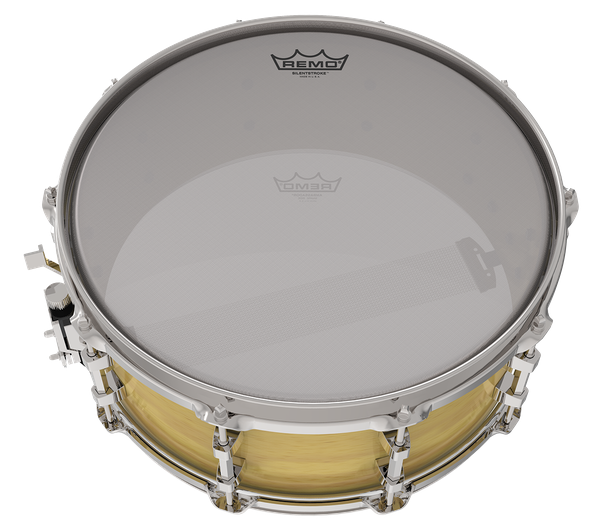
There are a few work-arounds which can help in reducing the volume further. If you can do without the resonant head ring, then you could either remove the heads themselves, or use some padding in the drum to kill the sound completely. This gives a more deadened sound, closer to playing a V-Drum electronic drum kit.
You can even go so far as to place a pillow inside each drum so that it makes contact with both the batter head and the resonant head. This will kill all tone and take a bit of spring away from the head response too. It’s not a bad option if you prefer the feel of low-tensioned toms which offer little rebound.
The same principle applies to the bass drum. Many drummers will already be using some form of dampening within the bass drum to begin with. When using Silentstroke heads on the kick drum it’s largely a case of finding the optimum tension. Too tight and the response can be too springy. Too loose and you risk causing damage to the drum head.
In this case you could make use of existing internal dampening or even do as I often do, which is to use a heavy feather pillow. This has the dual effect of reducing sound production and deadedning the drum head response.
Double & Triple-Ply
There are other mesh drum heads on the market which offer either double or even triple ply versions of this type of head. The obvious advantage to double and triple-ply heads is that they offer more durability. If you think a single-ply won’t last in your hands, then do consider these options.
The down-side to the extra ply is that these heads tend not to be as silent as single-ply. The extra ply reinforces the head but can increase the audible attack noise when striking the drum. This could be a deal-breaker for many drummers.
Drum Mutes
Drum head manufacturer Evans has their own line of drum mutes which, while not the most realistic, are extremely convenient. Sound Off drum mutes are basically a circular foam pad which sits directly on top of your existing drum head. The material has a spring to it so there is some rebound, but nothing on a par with the Remo Silentstroke heads.
Sound Off is a cheap and easy solution to noise reduction although you are sacrificing the real-feel here with more of a practice pad feel. Evans Sound Off can even be used on the hihat, ride or crash cymbals, as they provide alternate cuts for each. When it comes to cymbals, only a portion of the playing surface is covered, mainly the bow and the bell.
Practice Kits
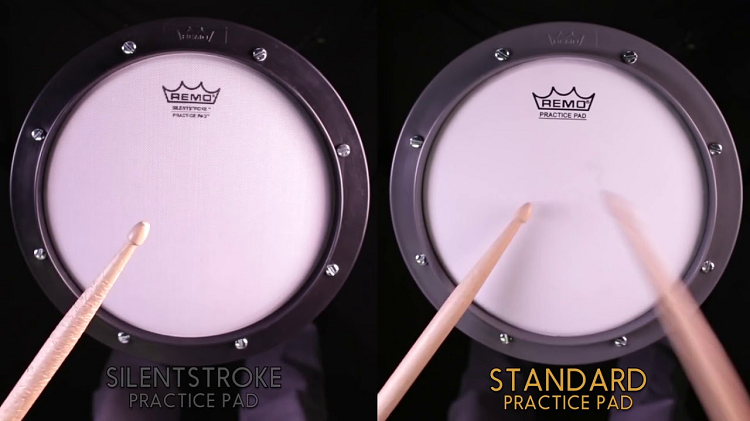
DW’s Go Anywhere practice set is a popular option for drummers who need more than just one practice pad. The Go Anywhere is effectively a drum kit made out of practice pads. There are 5 pads in total (snare, 3 toms and a kick drum) and they are made from a standard rubber-type material.
As the name might suggest, this practice set is ideal for drummers on the go. It folds up and can be carried in a hold-all over one shoulder. The set is reasonable priced and very durable. You can angle all pads using the pad mounting arms and the snare mount comes with additional adjustment options.
The sound response of the Go Anywhere kit is similar to a regular practice pad, although the kick pad tends to be a little louder. I find the Go Anywhere kit to be extremely convenient when you need to get some quick practice in about the house. Definitely one to keep in mind if you don’t have the room for a full acoustic drum set.
Low-volume Cymbals
It’s now possible to purchase low-volume cymbals which are made from alloys as opposed to rubber. Zildjian’s L80 is one such product which offers low-volume sound response with realistic stick response.
The L80’s effective look like an average set of metal cymbals with a bunch of holes drilled through them. The result is mightily impressive though. Sound reduction can anything be from 50-70% depending on your playing style.
Playing on the L80’s is much more enjoyable than regular V-Drum rubber cymbal pads. You can get a variety of sounds, much like playing on proper acoustic cymbals. The hihats are crisp but operate at a noticeably lower dynamic range. The ride has a playable bell which makes practicing way more fun.
Much like the Remo Silentstroke, if you need a further reduction in sound, you can apply a little tape underneath the bell of each cymbal and this will reduce some of the overtones. I use the L80’s along with the DW Go Anywhere practice kit and it works a charm.
Related Products
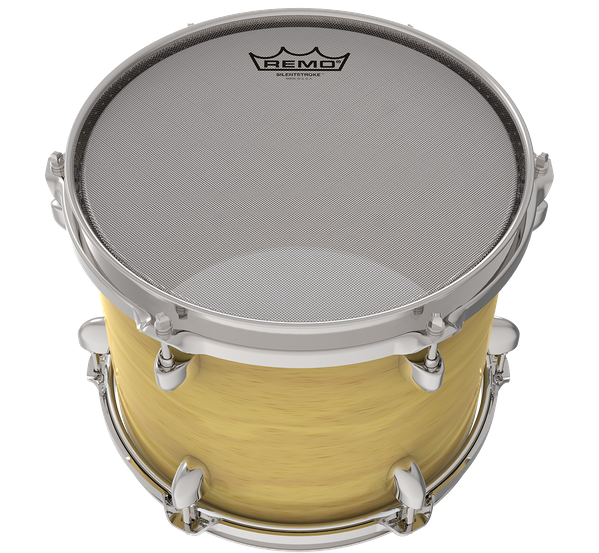
A nice feature of the Remo Silentstroke drum heads is that they are compatible with regular drum triggers. This means if you need more than the silent stick response you can effectively create your own V-Drum setup by adding a module, connecting cables and triggers.
A standard Roland RT-30H trigger simply clips onto the drum hoop and makes contact with the mesh drum head.
You could even combine this setup with a digital cymbal pack to complete your acoustic/V-Drum hybrid. Zildjian have taken the silent cymbal approach even further with their Gen16 cymbal packs.
These cymbals are not only extremely low volume to play on, they are also equipped with sensitive electronic triggers that allow them to be used in conjunction with a sound module. This means you have access to a wide range of sample sounds which can be assigned to individual cymbals.
Getting back to noise reduction, one relatively recent innovation is the introduction of ‘silent’ drumsticks. This is a roundabout approach to solving the problem of noise reduction. Instead of trying to quieten down the playing surface, this approach tackles the stick itself. Vic Firth have their SRH2CO which is a set of practice sticks designed with large rubber tips.
These sticks are ideal for playing on any hard surfaces and the great thing is you’ll never need to bring your practice pad.
We spoke earlier that even though the Remo Silentstroke drum heads are highly effective at reducing drum volume, they don’t address the issue of rim shots. Well, that’s where Rimwrap comes in. Produced by Shaw, Rimwrap is designed to fit any regular shaped drum hoop and comes in a number of different circumferences.
Rimwrap looks and acts just like the rim of a regular electronic V-Drum. It means that if you want to eliminate rim clicks from your practice routine, you can.
Remo Silentstroke Drum Heads
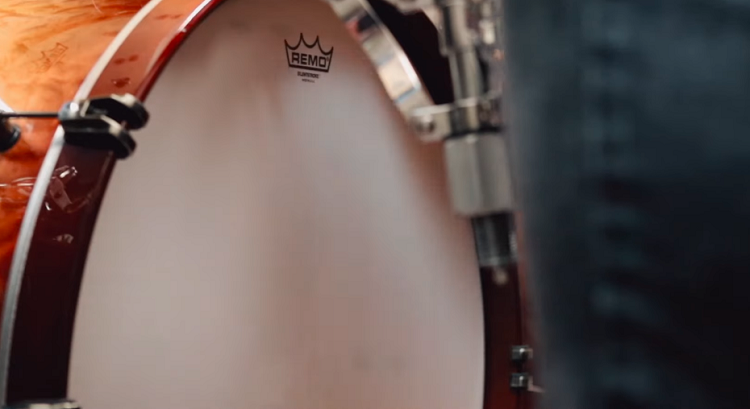
Pros
- Affordable
- Tensionable with a decent stick response
- Reasonably durable
- Can be used with triggers
Cons
- Changing heads over and back can be laborious
- They will still produce a low volume drum tone
FAQ’s
Answer: Not necessarily. Remo have many different custom packs available. For example, their Fusion pack comes with 10, 12 & 16-inch heads while the Rock pack comes with larger 12, 13 & 16-inch heads.
Answer: They’re quite durable although it’s wise to play with good technique so as to avoid puncturing the head. If you find you don’t damage your regular Mylar heads then you shouldn’t have anything to worry about. With single-ply mesh especially, you should make sure that your bass drum beater is not digging into the head.
Answer: While both drum heads are manufactured by Remo, they differ in the amount of ply used. Silentstroke drum heads are specifically designed as a substitute for regular heads on an acoustic drum set. Remo V-Drums are often supplied double-ply heads which act in two ways.
They offer more protection of the inner triggering and they have a different sound and response. Replacing your V-Drum with Silentstroke head is not recommended as you run the risk of damaging the inner electronic of the drum.
In this case it would be better to fork out the extra money for a suitable head, perhaps something like the Roland MH2 Powerply Mesh Head, which is designed to work with electronic triggering systems.
Answer: They’re not ideal for jazz brushes as the woven mesh head means the brush bristles can catch.
Final Thoughts
Remo Silentstroke drum heads are a great solution to a common problem. They won’t break the bank and are around the same price as a regular drum head (in some cases way cheaper!).
They take a bit of getting used to, as it’s initially pretty odd-feeling to be playing your regular drum kit with a 70% reduction in volume, but once you get over the lack of sound response, you’ll find them a great practice aid. Combine the Silentstrokes with some low-volume cymbals and you’re all set to practice in peace!
Also read:

